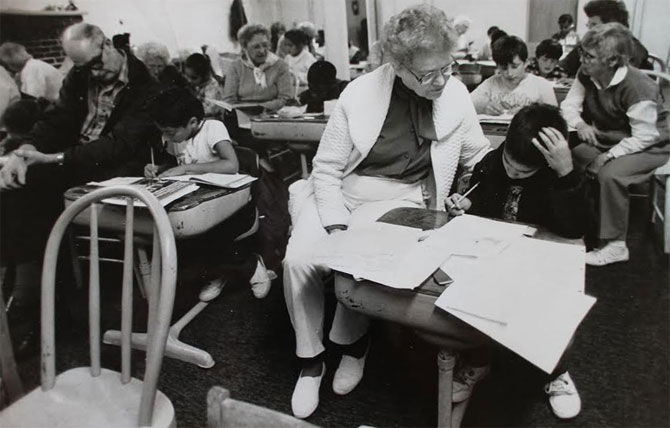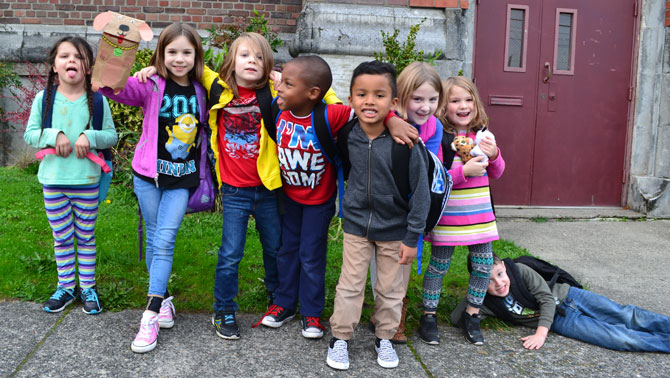At the end of a recent Sunday service at Trinity Presbyterian Church in Tacoma, Washington, a long line of worshippers headed outside to a scrubby lawn where a galvanized horse trough stood full of fresh, cold water.
The Rev. Matthew Robbins-Ghormley, in khaki shorts and a dark blue T-shirt, climbed in and waited for the first of three young adult catechumens to join him, beneath the blue sky for all to see.
The smiling crowd was full of children and families. Driving by, you might have thought a magic show or birthday party was underway, especially when cheers went up as each person was dunked under the water.
Trinity’s building is surrounded by the bleaker symbols of urban life, including graffiti-covered billboards, a homeless shelter and used needles in the grass outside the sanctuary door. Hilltop, as this district of Tacoma is known, has a record of serious gang activity, including homicides and a high crime rate.
It is also the place where Trinity is thriving. Over the past quarter-century, the church has resurged as a vital presence in the Hilltop community.
Trinity’s congregation grew by 33 percent between 2011 and 2016, and many of the newcomers were young people and families. Today the congregation has close to 200 adult members and more than 130 children.
Church leaders say this has come about, not through efforts focused on drawing people into the fold, but through a powerful form of “other-oriented” ministry, reaching out and serving the needs of those around them.
“The resurrection story of Trinity is the story of witnessing the activity of God in individual lives, in the church and in the neighborhood,” said the Rev. Lynn Longfield, the pastor of Trinity from 1987 to 1997. “We did not cause the resurrection but simply worked to see what God was doing and follow the Spirit’s lead.”
The outdoor baptism is just a small reflection of Trinity’s style of following Jesus; the congregation literally carried their love out the church doors.
Dating back to the mid-1980s, when a retired teacher and principal started a program to tutor neighborhood children, the congregation has developed an impressive list of outreach programs that touch thousands of people in the community.
But programs alone aren’t the core of the ministry, Robbins-Ghormley said.
“I appreciate that sense of ‘transformational presence’ that we hope to be in our neighborhood,” he said. “We all need transformation, and we all must be present to each other in our mutual need.”
Children and families at risk
This central area of Tacoma boasts a proudly diverse past -- in 1910, the residents of Hilltop were almost all immigrants, speaking a half-dozen different languages -- and the encompassing district is recognized on the National Register of Historic Places.
Trinity Presbyterian started out in 1891 as a congregation of 13 people who met in the downtown Tacoma YMCA; the masonry church building that now stands at the corner of 6th and Grant was built in 1922.
In the 1970s, the area gained a reputation for violence. And, despite efforts to improve downtown Tacoma, Hilltop continues to have a higher crime rate than other parts of the city.
As the neighborhood declined, Trinity, like many urban churches, grew smaller and grayer. Longfield recalls ministering to a shrinking group when she joined Trinity as part-time pastor in 1987.
“At the time, there were perhaps 25 folks present on Sunday, and the vast majority were white,” she said, despite the diversity of people living in the neighborhood.
Irene Orando, who joined Trinity in 1938 and raised her family in the church, remembers a night many years ago when she was the only person who showed up for an evening prayer gathering.

She walked around the empty, rarely used classrooms praying that one day they would be filled with children.
Within that small congregation, however, was a spark of community connectedness. As the neighborhood struggled with crime, drugs and violence, a modest tutoring program was started by a retired teacher and principal named Hazel Pflugmacher.
She headed a group of older women who would meet with local elementary school children after school to help them with homework and offer them a nutritious snack.
What needs in your neighborhood -- large or small -- could your organization begin to address?
“The congregation had always had a culture of engagement and service,” Longfield said. “And it became clear to Hazel and others in this stalwart little congregation that children and families were at risk.”
As members and staff got to know the families in the tutoring program, they saw that their neighbors also had other needs, and they began efforts to address those as well.
Longfield listened deeply to her congregation and gathered information from the community through surveys. By the time she left in 1997, there were 75 people in worship on Sundays. They had partnered with another Presbyterian church to establish a free neighborhood clinic. The church’s outreach programs had expanded beyond the tutoring program to include a clothing bank and Tony’s Kitchen, a weekly soup-and-conversation community lunch hour.

Today, the tutoring effort, now called the Trinity Afterschool Program (TAP), is still in full force, helping a dozen local first- and second-graders with literacy skills every day after school. Trinity also runs the Bobcat Learning Center, serving between 50 and 60 nearby middle school students.
Do you have existing efforts that could become a nucleus for greater outreach?
The empty rooms where Orando once prayed are now filled to overflowing during Sunday school as well as during the week. Overall, Trinity’s outreach programs serve 3,500 people every year.
“That’s where Trinity discovered its calling -- in mission, in getting to know its neighbors,” Robbins-Ghormley said.
Blurring the lines
When the Rev. Harlan Shoop took over the pulpit at Trinity in 2000, he was followed by a cadre of young people from University Place Presbyterian, the large suburban church where he had been pastor.
This infusion of students bolstered and grew the Trinity congregation, but Shoop also knew there would be challenges.
“I was aware the worship community was pretty small,” Shoop said. “The things that were keeping the church going were the outreach programs, which were what drew me in.”
They also began to draw in others. Young families saw “this mostly blue-collar bunch of older folks there a long time and found compelling how they were loving their community and engaged in being the church,” Robbins-Ghormley said about that period.
“If you sit down and ask people why they come to Trinity, they mention faith in action, community involvement,” he said.
If you asked members of your organization why they joined, what would they say?
Shoop was excited to see the growth -- but he also wanted to increase the dynamic connection between the worship and outreach communities in order, ideally, to grow them both.
“I wanted more of the folks getting served in the clothing bank to join us in worship,” he said.
The outreach programs that had been launched by elders in the worship community were, at this time, being managed by people hired from outside Trinity. Shoop thought it might change things if the church hired people who were engaged in both sides.
In 2007, Shoop brought on longtime Hilltop resident Rod Nash as director of outreach. Nash had been a member of the congregation for seven years and was trained in theology. He picked up on Shoop’s vision of blurring the sharp lines between the serving and the served.
“Trinity outreach programs are the visible expression of Trinity’s commitment to this neighborhood,” Nash said in a Trinity promotional video. “As they transform our lives, we transform their lives, together in this place that we love.”
Here for good
Robbins-Ghormley became part of Trinity in 2010, when the church already was thriving.
“I remember getting here and thinking, ‘I just hope I don’t mess it up,’” he said.
How can you lead from your organization's strengths and build upon them?
Growth continues. On a recent Sunday, there were 60 children and 80 adults in worship.
That said, the church is still trying to deepen its understanding of itself as a predominantly white and well-off congregation in an area that is racially and economically mixed.
“We recognize that we would love for our church to look a lot more like our neighborhood, but it hasn’t happened, exactly,” Robbins-Ghormley said.
Trinity is making efforts beyond serving, toward understanding and learning.
In an ongoing partnership called Conversations Around Race, Trinity and three other Tacoma churches (Allen AME, Peace Lutheran and Church of the Indian Fellowship) are exploring their commonalities and differences through the eyes of the gospel.
“The group has been working together for the past nine years,” Robbins-Ghormley said. “It was born out of Obama’s call to have conversations around race. We said, ‘Let’s start with the church.’”
As the congregation celebrates its 125th anniversary, it has launched a multimillion-dollar fundraising campaign to restore the building and further their neighborhood work. The campaign is called “Here for Good” -- a signal of their intent to continue serving the community.
One goal is to create a centralized place for education and support programs in the form of a neighborhood center in the lower level of the church.
Longfield says she sees Trinity’s journey over the past 25 years as “a story of coming to understand that we are not called to ‘save’ but to respect and value all people -- being willing, with commitment to hospitality, to journey together with others toward living out the love of God.”
Questions to consider
Questions to consider:
- What needs in your neighborhood -- large or small -- could your organization begin to address?
- Do you have existing efforts that could become a nucleus for greater outreach?
- If you asked members of your organization why they joined, what would they say?
- How can you lead from your organization's strengths and build upon them?











